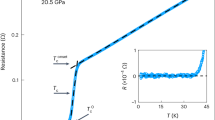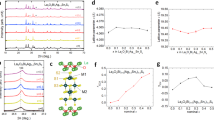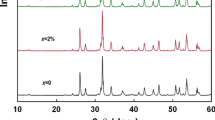Abstract
We have investigated the structural, electrical, and magnetic properties of oxychalcogenide LaREO2Bi3Ag0.6Sn0.4S6 (RE = Pr and Nd) superconductors. The LaREO2Bi3Ag0.6Sn0.4S6 (RE = Pr and Nd) samples are composed of a single La2O2Bi3AgS6 phase without any impurity phase. The superconducting onset temperature of LaREO2Bi3Ag0.6Sn0.4S6 (RE = Pr and Nd) is \(\sim \) 4.1 K, which is slightly higher than 2.8 K observed for La2O2Bi3Ag0.6Sn0.4S6.
Similar content being viewed by others
Avoid common mistakes on your manuscript.
1 Introduction
Since the discovery of superconductivity (SC) in Bi4O4S3 with an onset critical transition temperature of Tc,onset = 8.60 K [1], several BiS2-based layered compounds including REOBiS2 (RE = La, Ce, Pr, Nd, and Yb), SrFBiS2, Bi2OS2, and Bi3O2S3 have been discovered [2,3,4,5,6,7,8,9,10,11]. The crystal structure of the parent compound REOBiS2 is composed of alternate stacks of conducting BiS2 bilayers and insulating RE2O2 blocking layers. Although REOBiS2 is intrinsically an insulator with a band gap, SC was observed by partially substituting O at the RE2O2 blocking layers with F, which induces an electron carrier in the BiS2 layers. From the first-principles band-structure calculation, SC in BiS2-based compounds is derived from the Bi 6px and 6py orbitals [12]. Tc in REO1−xFxBiS2 is distributed in the range of 2–5 K, depending on RE elements. Among BiS2-based layered compounds, LaO0.5F0.5BiS2 synthesized under high pressure shows a maximum Tc,zero\(\simeq \) 10.5 K [13]. In the case of CeO0.5F0.5BiS2 with Tc,onset\(\simeq \) 3.0 K, the coexistence of SC and ferromagnetism arising from the local moments of Ce at low temperatures was confirmed from the electrical resistivity and magnetization measurements [3, 14].
Recently, Jha et al. [15] reported SC in the layered oxychalcogenide La2O2Bi3AgS6 with Tc\(\simeq \) 0.5 K. The crystal structure of La2O2Bi3AgS6 is composed of alternate stacks of LaOBiS2-type layers and rock-salt-type (Bi,Ag)S layers. They also observed a broad hump in the temperature dependence of resistivity below T∗\(\sim \) 180 K, possibly due to the charge density wave (CDW) transition. In La2O2Bi3Ag1−xSnxS6, Tc increased and a broad hump in the temperature dependence of resistivity weakened, with increasing Sn content from x = 0 to 0.5 [16]. The broad hump in the temperature dependence of resistivity disappeared for x≥ 0.3, and the maximum superconducting onset temperature, Tc,onset, achieved was 2.8 K at x = 0.4.
This paper reports the structural, electrical, and magnetic properties of oxychalcogenide LaREO2Bi3Ag0.6Sn0.4 S6 (RE = Pr and Nd) superconductors. In LaREO2Bi3Ag0.6 Sn0.4S6, the lattice parameter c is insensitive with RE = Pr or Nd, but the lattice parameter a decreases monotonically with decreasing ionic radius of RE. The superconducting onset temperature on LaREO2Bi3Ag0.6Sn0.4S6 (RE = Pr and Nd), which determined by the electrical resistivity and magnetization measurements, is \(\sim \) 4.1 K.
2 Experimental
Polycrystalline samples of LaREO2Bi3Ag0.6Sn0.4S6 (RE = Pr and Nd) were synthesized using a solid state reaction method. Powders of La2O3 (99.99 %), Pr2O3 (99.9 %), Nd2O3 (99.9 %), La2S3 (99.9 %), Ag2O (99.9 %), Bi (99.999 %), Sn (99.8 %), and S (99.5 %) with a nominal composition of LaREO2Bi3Ag0.6Sn0.4S6 were mixed, pressed into pellets, and sealed in an evacuated quartz tube. As mentioned in Refs. [15] and [16], the sintering temperature was 725 ∘C with a sintering period of 15 h. The sintering procedure was repeated for one more time to achieve a homogeneous combination reaction with an intermediate grinding with the same sintering temperature and period. On the other hand, the properties of the samples, obtained using two sintering steps at 725 ∘C, were not acceptable, which may be caused by the two sintering steps at high temperature. The optimal sintering temperatures for each sample were determined by examining the XRD results and magnitude of zero field-cooled magnetization at 2 K. As a result, after first sintering at 720 ∘C for 15 h, the samples were sintered at 670 ∘C in the second step for 15 h to minimize the loss of metallic elements such as Bi, Ag, and Sn. Attempts were also made to synthesize RE2O2Bi3Ag0.6Sn0.4S6 (RE = Ce and Nd) and LaREO2Bi3Ag0.6Sn0.4S6 (RE = Y, Ce, and Sm) samples using the our method and the procedure suggested in Refs. [15] and [16]. Unfortunately, these samples contained excessive impurities induced by the loss of metallic elements.
The phase purity of the prepared samples was examined by X-ray diffraction (XRD) using a Cu Kα radiation at room temperature. The electrical resistivity down to 2 K was measured by a standard four-probe method in a commercial Quantum Design PPMS-14 system. The magnetic properties were measured over the temperature range, 2 K to 8 K, using the Physical Property Measurement System (PPMS, Quantum Design).
3 Results and Discussion
Figure 1a presents the room temperature XRD pattern of polycrystalline LaREO2Bi3Ag0.6Sn0.4S6 (RE = Pr and Nd) samples. The structure of La2O2Bi3AgS6 is tetragonal with the space group P4/nmm [17]. As shown in Fig. 1a, the XRD peaks for the LaREO2Bi3Ag0.6Sn0.4S6 (RE = Pr and Nd) samples are indexed to the La2O2Bi3AgS6 phase, indicating that the samples are composed of a single phase without an impurity phase. Figure 1 b shows the (006) peaks on LaREO2Bi3Ag0.6Sn0.4S6 (RE = Pr and Nd). The shift in the (006) peak was not noticeable, suggesting that the lattice parameter c is not sensitive to RE = Pr or Nd. On the other hand, the (110) peak shifts toward a higher angle side as the RE is changed from Pr to Nd (see, Fig. 1c), i.e., the lattice parameter a decreases with decreasing ionic radius of RE from 1.179 Å (Pr3+) to 1.163Å (Nd3+) [18].
The estimated lattice parameters based on the XRD peaks are a = 4.0320 Å and c = 19.37 Å for LaPrO2Bi3Ag0.6Sn0.4S6 and a = 4.024 Å and c = 19.37 Å for LaNdO2Bi3Ag0.6Sn0.4S6. The c = 19.37 Å for LaREO2Bi3Ag0.6Sn0.4S6 (RE = Pr and Nd) is shorter than c = 19.45 Å on La2O2Bi3Ag0.6Sn0.4S6 [16]. The a decreases monotonically from 4.065 Å [16], to 4.0320 Å to 4.024 Å as RE goes from La to Pr to Nd, as mentioned above.
Figure 2 shows the temperature dependence of the electrical resistivity, ρ(T), of polycrystalline LaREO2Bi3 Ag0.6Sn0.4S6 (RE = Pr and Nd). As shown in Fig. 2, ρ(300 K) for the LaPrO2Bi3Ag0.6Sn0.4S6 (\(\sim \) 3.0 mΩ ⋅cm) and LaNdO2Bi3Ag0.6Sn0.4S6 (\(\sim \) 3.3 mΩ ⋅cm) is slightly smaller than that (\(\sim \) 3.5 mΩ ⋅cm) of La2O2Bi3Ag0.6Sn0.4S6 [16]. The ρ(T) of La2O2Bi3Ag0.6Sn0.4S6 was reported to show simple metallic behavior at the normal state below 300 K, which was then followed by an upturn at \(\sim \) 100 K upon lowering temperature [16]. The LaREO2Bi3Ag0.6Sn0.4S6 (RE = Pr and Nd) exhibits the upturn behavior after a simple metallic behavior upon lowering temperature. On the other hand, the upturn trend in ρ(T) weakens progressively and the upturn temperature decreases from \(\sim \) 100 K (La) to \(\sim \) 50 K (Pr), and finally to \(\sim \) 25 K (Nd), accompanied by an increase in dρ/dT before the upturn in ρ(T) at the normal state, as RE goes from La to Nd.
The inset in Fig. 2 shows a plot of ρ(T) over the region close to Tc on polycrystalline LaREO2Bi3Ag0.6Sn0.4S6 (RE = Pr and Nd). Both the LaPrO2Bi3Ag0.6Sn0.4S6 and LaNdO2Bi3Ag0.6Sn0.4S6 samples exhibit the superconducting onset temperature of Tc,onset\(\simeq \) 4.1 K, which is higher than that (\(\simeq \) 2.8 K) of La2O2Bi3Ag0.6Sn0.4S6 [16]. However, Tc,zero (\(\simeq \) 3.5 K) of LaPrO2Bi3Ag0.6Sn0.4S6 is slightly higher than that (\(\simeq \) 3.4 K) of LaNdO2Bi3Ag0.6Sn0.4S6 and that (\(\simeq \) 2.4 K) of La2O2Bi3Ag0.6Sn0.4S6 as shown in the inset of Fig. 2 [16].
Figure 3a and b shows the temperature dependence of zero field-cooled (ZFC) and field-cooled (FC) magnetizations, MZFC and MFC, of the polycrystalline LaREO2Bi3Ag0.6Sn0.4S6 (RE = Pr and Nd) samples, which is measured under an applied magnetic field of H = 10 Oe down to 2 K.
a Temperature dependence of MZFC and MFC on polycrystalline LaPrO2Bi3Ag0.6Sn0.4S6 sample under H = 10 Oe. The upper and lower insets show an enlargement of the region close to Tc and temperature dependence of MZFC and MFC under H = 10 Oe, respectively. b Temperature dependence of MZFC and MFC on polycrystalline LaNdO2Bi3Ag0.6Sn0.4S6 sample under H = 10 Oe. The inset show an enlargement of the region close to Tc
The magnitude of MZFC at 2 K (\(\simeq \) − 0.09 emu/g) of LaPrO2Bi3Ag0.6Sn0.4S6, given in Fig. 3a, is almost 1.5× larger than that (\(\simeq \) − 0.06 emu/g) of PrO0.5F0.5BiS2 measured at H = 5 Oe. The MFC, which is measured under a low field of H = 10 Oe, features a paramagnetic signal at low temperatures with a transition at \(\sim \) 4.2 K, as shown in the upper inset of Fig. 3b. Moreover, MZFC around Tc is also paramagnetic, displaying a positive peak over a narrow temperature range below Tc, which is followed by a diamagnetic response at lower temperatures. The positive peak in MZFC below Tc has also been observed in polycrystalline Bi2Sr2CaCu2O8 (Bi-2212), Nb disks, MgB2, and Pb [19,20,21,22,23,24]. Such MZFC and MFC features in superconductors are generally referred to as the paramagnetic Meissner effect (PME). Fang et al. [25] observed the putative PME in samples with x = 0.1 and 0.5 of La1−xSmxO0.5F0.5BiS2. The putative PME in the present LaPrO2Bi3Ag0.6Sn0.4S6 sample disappears as the magnetization is measured under H = 20 Oe (see the lower inset in Fig. 3a). The disappearance of PME by the increase in magnetic field is common to other superconductors, such as Bi-2212 showing PME. From the lower inset in Fig. 3a without the putative PME, the superconducting transition temperature is Tc\(\simeq \) 4.2 K, which is similar to Tc,onset in ρ(T). This is consistent with the paramagnetic transition temperature of MFC measured under H = 10 Oe in LaPrO2Bi3Ag0.6Sn0.4S6, and higher than Tc\(\simeq \) 3.7 K of PrO0.5F0.5BiS2 [6].
LaNdO2Bi3Ag0.6Sn0.4S6 (Fig. 3b) exhibits the general superconducting transition without the putative PME observed in LaPrO2Bi3Ag0.6Sn0.4S6. From the temperature dependence of MZFC shown in Fig. 3b, it is expected that the values of MZFC appear to be saturated at T < 2 K, which means that the bulk SC can be achieved. The shielding volume fraction of LaPrO2Bi3Ag0.6Sn0.4S6 (LaNdO2Bi3Ag0.6Sn0.4S6) estimated from 4πχ(ZFC) at 2 K is nearly 35% (98%). From the inset in Fig. 3b, Tc of LaNdO2Bi3Ag0.6Sn0.4S6 is 4.1 K, which is lower than Tc\(\simeq \) 5.0 K of NdO0.5F0.5BiS2 showing the highest Tc among the BiS2-based compounds synthesized at ambient pressure [4]. The absence of PME for LaNdO2Bi3Ag0.6Sn0.4S6 (Fig. 3b) at 10 Oe indicates clearly that the positive FC for LaPrO2Bi3Ag0.6Sn0.4S6 is PME.
4 Summary
In summary, this study examined the structural, electrical, and magnetic properties of oxychalcogenide LaREO2Bi3Ag0.6Sn0.4S6 (RE = Pr and Nd) superconductors. The lattice parameter c (a) of LaREO2Bi3Ag0.6Sn0.4S6 (RE = Pr and Nd) samples with a single phase of La2O2Bi3AgS6 is insensitive on RE = Pr or Nd (decreases monotonically with decreasing ionic radius of RE). The superconducting onset temperature of LaREO2Bi3Ag0.6Sn0.4S6 (RE = Pr and Nd) is \(\sim \) 4.1 K, which is slightly higher than 2.8 K of La2O2Bi3Ag0.6Sn0.4S6.
References
Mizuguchi, Y., Fujihisa, H., Gotoh, Y., Suzuki, K., Usui, H., Kuroki, K., Demura, S., Takano, Y., Izawa, H., Miura, O.: . Phys. Rev. B 86, 220510 (2012)
Lee, J., Stone, M.B., Huq, A., Yildirim, T., Ehlers, G., Mizuguchi, Y., Miura, O., Takano, Y., Deguchi, K., Demura, S., Lee, S.-H.: . Phys. Rev. B 87, 205134 (2013)
Xing, J., Li, S., Ding, X., Yang, H., Wen, H.-H.: . Phys. Rev. B 86, 214518 (2012)
Demura, S., Mizuguchi, Y., Deguchi, K., Okazaki, H., Hara, H., Watanabe, T., Denholme, S.J., Fujioka, M., Ozaki, T., Fujihisa, H., Gotoh, Y., Miura, O., Yamaguchi, T., Takeya, H., Takano, Y.: . J. Phys. Soc. Jpn. 82, 033708 (2013)
Kajitani, J., Deguchi, K., Hiroi, T., Omachi, A., Demura, S., Takano, Y., Miura, O., Mizuguchi, Y.: . J. Phys. Soc. Jpn. 83, 065002 (2014)
Jha, R., Tiwari, B., Awana, V.P.S.: . J. Phys. Soc. Jpn. 83, 063707 (2014)
Yazici, D., Huang, K., White, B.D., Chang, A.H., Friedman, A.J., Maple, M.B.: . Philos. Mag. 93, 673 (2013)
Shao, J., Yao, X., Liu, Z., Pi, L., Tan, S., Zhang, C., Zhang, Y.: . Supercond. Sci. Technol. 28, 015008 (2015)
Phelan, W.A., Wallace, D.C., Arpino, K.E., Neilson, J.R., Livi, K.J., Seabourne, C.R., Scott, A.J., McQueen, T.M.: . J. Am. Chem. Soc. 135, 5372 (2013)
Shao, J., Liu, Z., Yao, X., Pi, L., Tan, S., Zhang, C., Zhang, Y.: . Phys. Status Solidi RRL 8, 845 (2014)
Li, L., Parker, D., Babkevich, P., Yang, L., Ronnow, H.M., Sefat, A.S.: . Phys. Rev. B 91, 104511 (2015)
Morice, C., Artacho, E., Dutton, S.E., Molnar, D., Kim, H.-J., Saxena, S.S.: . J. Phys.: Condens. Matter 27, 135501 (2015)
Mizuguchi, Y., Hiroi, T., Kajitani, J., Takatsu, H., Kadowaki, H., Miura, O.: . J. Phys. Soc. Jpn. 83, 053704 (2014)
Lee, J., Demura, S., Stone, M.B., Iida, K., Ehlers, G., dela Cruz, C.R., Matsuda, M., Deguchi, K., Takano, Y., Mizuguchi, Y., Miura, O., Louca, D., Lee, S.-H.: . Phys. Rev. B 90, 224410 (2014)
Jha, R., Goto, Y., Higashinaka, R., Matsuda, T.D., Aoki, Y., Mizuguchi, Y.: . J. Phys. Soc. Jpn. 87, 083704 (2018)
Jha, R., Goto, Y., Matsuda, T.D., Aoki, Y., Nagao, M., Tanaka, I., Mizuguchi, Y.: arXiv:1810.08404
Hijikata, Y., Abe, T., Moriyoshi, C., Kuroiwa, Y., Goto, Y., Miura, A., Tadanaga, K., Wang, Y., Miura, O., Mizuguchi, Y.: . J. Phys. Soc. Jpn. 86, 124802 (2017)
Shannone, R.D.: . Acta Cryst. A32, 751 (1976)
Chaban, I.A.: . J. Supercond. 13, 1011 (2000)
Thompson, D.J., Minhaj, M.S.M., Wenger, L.E., Chen, J.T.: . Phys. Rev. Lett. 75, 529 (1995)
Braunisch, W., Knauf, N., Kataev, V., Neuhausen, S., Grutz, A., Kock, A., Roden, B., Khomskii, D., Wohlleben, D.: . Phys. Rev. Lett. 68, 1908 (1992)
Sozeri, H., Dorosinskii, L., Topal, U., Ercan, I.: . Phys. C 408–410, 109 (2004)
Yuan, S., Ren, L., Li, F.: . Phys. Rev. B 69, 092509 (2004)
Papadopoulou, E.L., Nordblad, P., Svedlindh, P., Schoneberger, R., Gross, R.: . Phys. Rev. Lett. 82, 173 (1999)
Fang, Y., Yazici, D., White, B.D., Maple, M.B.: . Phys. Rev. B 91, 064510 (2015)
Funding
This work was supported by a 2-Year Research Grant of Pusan National University.
Author information
Authors and Affiliations
Corresponding author
Additional information
Publisher’s Note
Springer Nature remains neutral with regard to jurisdictional claims in published maps and institutional affiliations.
Rights and permissions
About this article
Cite this article
Kim, G.C., Cheon, M., Choi, W. et al. Superconductivity in Oxychalcogenide LaREO2Bi3Ag0.6Sn0.4S6 (RE = Pr and Nd). J Supercond Nov Magn 33, 625–628 (2020). https://doi.org/10.1007/s10948-019-05218-1
Received:
Accepted:
Published:
Issue Date:
DOI: https://doi.org/10.1007/s10948-019-05218-1







